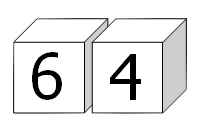* fix: improve Project Euler descriptions and test case Improve formatting of Project Euler test descriptions. Also add poker hands array and new test case for problem 54 * feat: add typeof tests and gave functions proper names for first 100 challenges * fix: continue fixing test descriptions and adding "before test" sections * fix: address review comments * fix: adjust grids in 18 and 67 and fix some text that reference files rather than the given arrays * fix: implement bug fixes and improvements from review * fix: remove console.log statements from seed and solution
2.3 KiB
id, challengeType, title, forumTopicId
| id | challengeType | title | forumTopicId |
|---|---|---|---|
| 5900f3c61000cf542c50fed9 | 5 | Problem 90: Cube digit pairs | 302207 |
Description
Each of the six faces on a cube has a different digit (0 to 9) written on it; the same is done to a second cube. By placing the two cubes side-by-side in different positions we can form a variety of 2-digit numbers.
For example, the square number 64 could be formed:

In fact, by carefully choosing the digits on both cubes it is possible to display all of the square numbers below one-hundred: 01, 04, 09, 16, 25, 36, 49, 64, and 81.
For example, one way this can be achieved is by placing {0, 5, 6, 7, 8, 9} on one cube and {1, 2, 3, 4, 8, 9} on the other cube.
However, for this problem we shall allow the 6 or 9 to be turned upside-down so that an arrangement like {0, 5, 6, 7, 8, 9} and {1, 2, 3, 4, 6, 7} allows for all nine square numbers to be displayed; otherwise it would be impossible to obtain 09.
In determining a distinct arrangement we are interested in the digits on each cube, not the order.
{1, 2, 3, 4, 5, 6} is distinct from {1, 2, 3, 4, 5, 9}
But because we are allowing 6 and 9 to be reversed, the two distinct sets in the last example both represent the extended set {1, 2, 3, 4, 5, 6, 9} for the purpose of forming 2-digit numbers.
How many distinct arrangements of the two cubes allow for all of the square numbers to be displayed?
Instructions
Tests
tests:
- text: <code>cubeDigitPairs()</code> should return a number.
testString: assert(typeof cubeDigitPairs() === 'number');
- text: <code>cubeDigitPairs()</code> should return 1217.
testString: assert.strictEqual(cubeDigitPairs(), 1217);
Challenge Seed
function cubeDigitPairs() {
// Good luck!
return true;
}
cubeDigitPairs();
Solution
// solution required